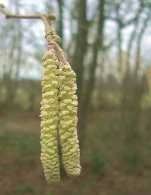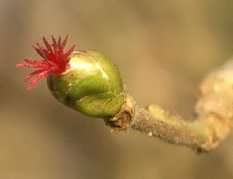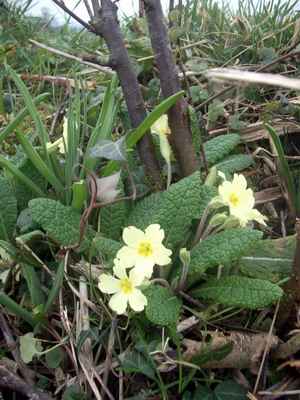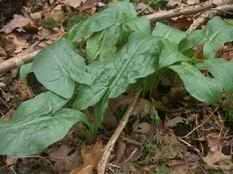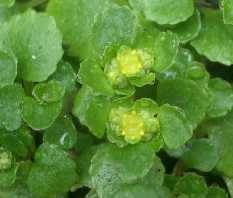When to Watch Wildlife |
J | F | M | A | M | J | J | A | S | O | N | D | Search |
Current wildlife highlights |
||
|
What's new on this site |
||
|
Wildlife calendar |
||
|
Plants and Animals |
||
|
Habitats |
||
|
Wildlife sites |
||
|
WWW links |
||
|
Guide Books |
||
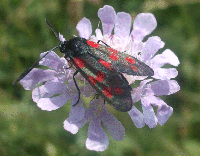 |
||
|
© PMcS 2006 |
|
February |
||||||||
|
||||||||
|
This month look out for:
The month of February can be as harsh as any, with snow and freezing winds. However its is possible to spot hints of better things to come. Although spring is still several weeks away the first signs are there to see. Hazel catkins have started to expand into golden tassels in order to release their pollen to the wind. The female part of the hazel plant, which catches the wind borne pollen, consists of a tiny red cone of red stigmas.
hazel plant's female 'pollen receptors' The beautiful and delicate snowdrops now poke their heads above the cold earth in abundance. Although not native in many places they have become naturalised and can carpet the woodland floor. Snowdrops have particularly spread along river banks in some localities. Winter aconite are also early flowering introductions, with their cheerful yellow buttercup like flowers. In the world of birds the winter migrants are still in Britain. The estuaries are full of waders furiously feeding for worms and other titbits in the mud. Ducks are also to be found in large flocks on estuaries, along with geese and swans at some locations. Some birds have already started to sing. Mistle and song thrushes proclaim their territory from lofty perches. On the sunnier days a great tit may sing its repetitive "tea-cher tea-cher" song. For more information on bird songs visit the bird song page. At the garden bird tables small birds are more than ever in need of the food put out for them to see them through the cold nights. Siskins may be a treat at this time of year for the garden bird watcher. Some birds, such as blue tits, are already prospecting for nesting sites and hence it is important to get bird boxes in place straight away. If you are lucky you may have visiting waxwings. These tropical looking visitors are in fact from Scandinavia. They work their way through the country feeding on any berry laden rowan trees, starting in the north east and moving to the south west. As they are normally birds of the wild they seem to ignore humans to some extent, which permits great views if you are lucky. They feed in bursts, then rest and preen for a period, only to start feeding again. Often in large flocks they call to one another with a pleasant piping chatter. |
||||||||
| Habitats and species |
||||||||
|
Parks and gardens:
Carry on feeding garden birds and putting out water. This can be
the harshest time for birds as food supplies may be exhausted and your
offering can make a real difference to bird survival. Flocks of
wintering thrushes (red wings and field fares) move around
together in search of berries and other food. At night they can be
heard calling to one another with a distinctive metallic chack noise or
a high pitched whistle. |
||||||||
Woodlands
(including wood pasture): In woodlands the most obvious leaves
to emerge are those of the cuckoo pint (or lord and ladies).
The leaves push up through the leaf litter furled up but then open out
once above ground. Dogs mercury and violet leaves
will also start to green up the woodland floor between the clumps of
mosses. Other plants such as ramsons and the leaves of
bluebells start to poke through the leaf litter. Late on this
month precocious primroses may first appear.
Where the ground is waterlogged opposite-leaved golden-saxifrage bears its tiny yellow flowers. Occasionally you may come across a rosette of red spotted, broad leaves. This is an early purple orchid.
Flocks of small birds moving (often mainly great,
blue and other tits accompanied by finches, nuthatches
and treecreepers) can been seen best with the leaves off the
trees. Their feeding has a real urgency but they are easily
spooked. You may be lucky enough to hear and see a great
spotted woodpecker drumming against a tree trunk. |
||||||||
|
Arable and hedgerows: Hedgerows show little sign of life other than
the hazel catkins. Arable fields are still dormant with finches,
crows and pigeons searching for food. Some rookeries
are starting to show activity on milder days with rooks
squabbling over sticks and territory. |
||||||||
|
Road verges: Colour is returning to the dirty road verges in the
form of the green shoots of grasses, nettles and clumps of cowparsley
and goosegrass. Few of the shrubs are in bud until
later in the month. |
||||||||
|
Chalk and limestone grasslands: |
||||||||
|
Meadows (neutral) and flood plain grasslands: |
||||||||
|
Acidic grasslands: |
||||||||
|
Heathlands: |
||||||||
|
Mountain and Moorlands (uplands): |
||||||||
|
Rivers, lakes and ponds (including bogs and mires): Rivers are often
high at this time of the year, but without the cover of leaves grey
wagtails, dippers and kingfishers can be spotted more
easily. On larger ponds and lakes great crested grebes can be
seen pairs. They have an elaborate courtship dance which involves
the exchange of gifts of water weed, and which is performed at this time
of year. |
||||||||
|
Sea
and the sea shore (including estuaries): On the coast lapwings
can often be seen in large flocks as they are forced from the frozen
fields. They join waders such as curlew and redshank,
and ducks such as wigeon, teal, tufted duck,
pintail and scaup. |
||||||||
|
Mammals:
There may well be signs of badgers in the warmer periods or
further south. Bedding may appear outside sets as the badger
carries out some house keeping. The old winter bedding is removed
and replaced in readiness for the arrival of the new years young. |
||||||||
|
Birds: In
February perhaps our most elegant bird, the heron, starts to get
amorous! Herons nest in groups in heronries. These
consist of 4-20 large nests in tree tops and are used year after year.
An unusual courtship dance by the male precedes mating. He
stretches his neck up then lowers it over his back, with his bill bill
pointing upwards. Three to five eggs are laid from February
onwards. The birds are raucous and fascinating to watch. It's around
now that you may also be lucky enough to see the courtship dance of the
beautiful great crested grebes. This is a structured
performance between the male and the female with even special names for
each phase, and in fact can be seen right through the breeding season.
The phases are: 'advertising' (the come-and-get-me all), 'discovery
ceremony' (which includes the cat and penguin display), 'headshaking',
'penguin dance' (where both rear up out of the water facing one
another), 'the retreat', 'fish offering' and finally 'inviting'...and
the rest we leave to your imagination! |
||||||||
|
Amphibians & Reptiles: Frogs are still emerging from their
wintering hiding places and move towards their chosen breeding ponds.
In the south west frogs have already been spawning for several weeks,
and as the month progresses the more northerly ponds fill with spawn. |
||||||||
|
Insects: |
||||||||
|
Plants: |
||||||||
| Fungi | ||||||||
|
|
All images and text are copyright PMcS 2006
